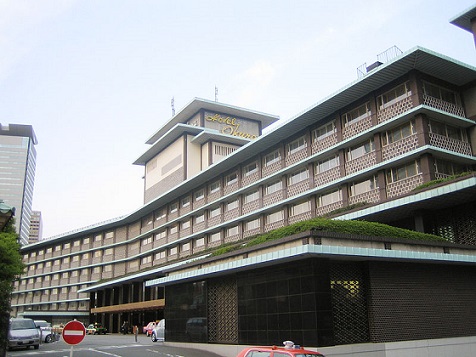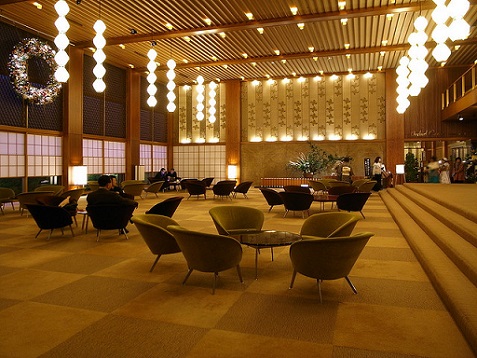Via Curtis M., Tokyo’s Hotel Okura is slated for demolition.
Five decades ago it was a gem of architecture, combining Japanese aesthetic and modernism.

It’s across from the US Embassy, so has been a watering hole for ex-pats, State Department employees, and people who merely list their official employer as the State Department.
Presidents from Nixon to Obama visited the hotel. So did Harrison Ford, Madonna, and Michael Jackson. And James Bond, in the novel You Only Live Twice.
‘Taking you to your hotel first – the Okura, latest of the Western ones. American tourist got murdered at the Royal Oriental the other day and we don’t want to lose you all that soon. Then we’ll do a bit of serious drinking. Had some dinner?’
The hotel, a Leading Hotels of the World property, will see its Main Wing close for demolition in August (its South Tower will continue to function). Re-opening is slated for 2019 and construction will cost about US$1 billion.
I really like the mid-century modernist motif, made popular again by Mad Men. It’s how I remember my grandparents’ home growing up.

But I wouldn’t choose to stay there, and contra the Washington Post‘s piece on the demolition the decision isn’t driven by “Japan’s tear-down culture” but rather economics.
A 50-year old hotel that has seen little renovation since no longer commands the room rates which provide the return on Tokyo’s expensive land. Earthquake standards have improved. Rooms at luxury hotels are far larger than they used to be in Tokyo. The hotel scene there has seen the introduction of fabulous new properties over the past decade against which this one hasn’t competed well.
There’s a movement to preserve the hotel — a petition and a hash tag. The movement doesn’t include booking actual room nights, let alone at a rate high enough to preserve the hotel.
We may like the idea of the Okura. But will we stay there in its current form enough and at a price necessary to sustain it? The owners are betting not — and they’re placing a billion dollar bet.
- You can join the 50,000+ people who see these deals and analysis every day — sign up to receive posts by email (just one e-mail per day) or subscribe to the RSS feed. It’s free. You can also follow me on Twitter for the latest deals. Don’t miss out!


They could just take a page from Japan’s preservation Playbook and move part of it to Meiji Mura. They did that with the lobby of the former Imperial Hotel in Tokyo.
http://www.meijimura.com/english/
Love the truth of the title. It reminds me of the old semi-historic brick apartment building right outside my office which was torn down a few months ago. When the plans were announced, the protesters came out, but where were they when they were trying to rent out the units and could actually have made a difference?
@ Gary – I think you’ve made an assumption here, based on your ideological proclivities – that the Okura, in its current form, is unable to rent rooms “at a price necessary to sustain it”, and that replacing the building is a rational economic response to that.
In the Washington Post article, there is no reference to the hotel’s profitability. In fact, I would guess that it remains profitable, but that the owners – hoping to cash in on the Olympic Games – want to increase the profit.
You and I would agree that there’s nothing inherently wrong with that. It is private property, after all.
But I do think that property developers are not always forward thinking or rational in their approach to these matters; and City governments (like Tokyo) also have a long history of making poor long-term economic decisions based on contemporary trends.
The Imperial Hotel in Tokyo is a perfect example – they knocked down the original Frank Lloyd Wright building for similar reasons, and yet I would guess that the hotel – 40 years on – would be commanding significantly higher rates today had the building remained. Not everyone wants to stay in a modern glass tower – take a look at any of the Parisian palace hotels to see just how high a room rate can be in a historical building.
And in New York, here we are 45 years after the destruction of Penn Station, trying to figure out what we can do to bring back some semblance of an attractive passenger experience by moving further west into the old post office, which is the same age as the old, destroyed station – and, of course, at great cost to the taxpayer. New is not always better.
I am making assumptions about all of this, like you, but I do believe there is value in retaining important architectural landmarks, especially when that value is sure to increase long after the excitement of opening your window shades with an ipad is gone. The hotel industry is riddled with short term gains trumping long term value creation. I believe that the destruction of the main Okura building may well be another example.
I fully agree with Joe. Maybe the hotel isn’t commanding the rate structure it wants; a full renovation maintaining the building’s architectural integrity can resolve that, and more quickly than a tear down would. Once the tower is replaced with a boring glass box, the hotel will be competing with every other boring glass box. Hopefully the hotel’s current owners realize that, once this classic building is gone, it’ll be gone forever.
I love the Hotel Okura, and we had a blast over there during the new years holidays…walking to it from the Andaz Tokyo, where we actually stayed.
I wish they would do with the lobby what they did with Frank Lloyd Wright’s classic Imperial Hotel, which was disassembled and rebuilt at the Meiji Mura theme park, where it lives on to this day.
Sad because this place is an absolute gem, but that said, we stayed at the Grand Hyatt. I think if there is any hope for “nostalgic” properties like this, it is to completely remodel, keep a few classic elements and try to for that upscale retro-chic feel. I think the fountainebleau Miami is a good example of how to make it work, but with some serious $$$$
My father survived the great Kanto earthquake and fire while staying at the FLW designed Imperial Hotel. I stayed there in the mid-50’s and in later years spent many nights at he Okura. I was sad to see the Imperial go and will be nearly as sad to say goodbye to the Okura.
That said, I must admit that I now usually stay at the Inter-Continental at Tokyo Bay, as I am Royal Ambassador and get fine treatment there.
I have stayed at the Okura once, two years ago. But that was because I was attending a business event there. Would not have stayed there otherwise. Do not plan to do so anytime soon. The hotel feels old, not in a good way.
I look forward to giving it another try after they rebuild.